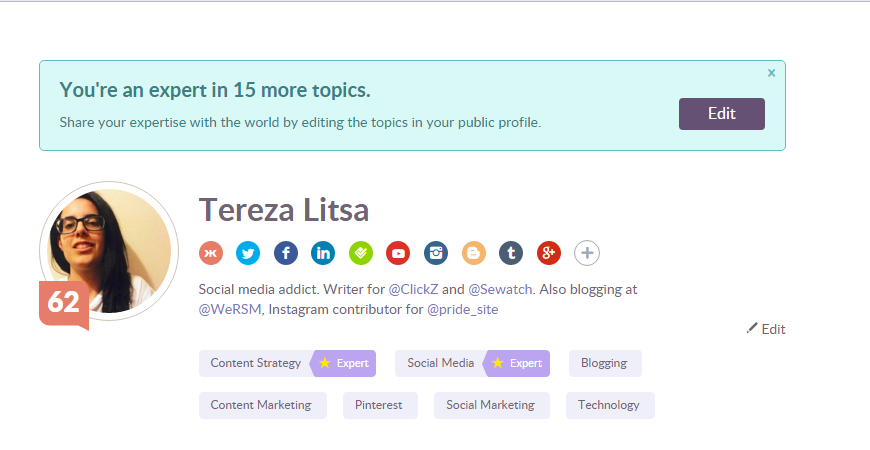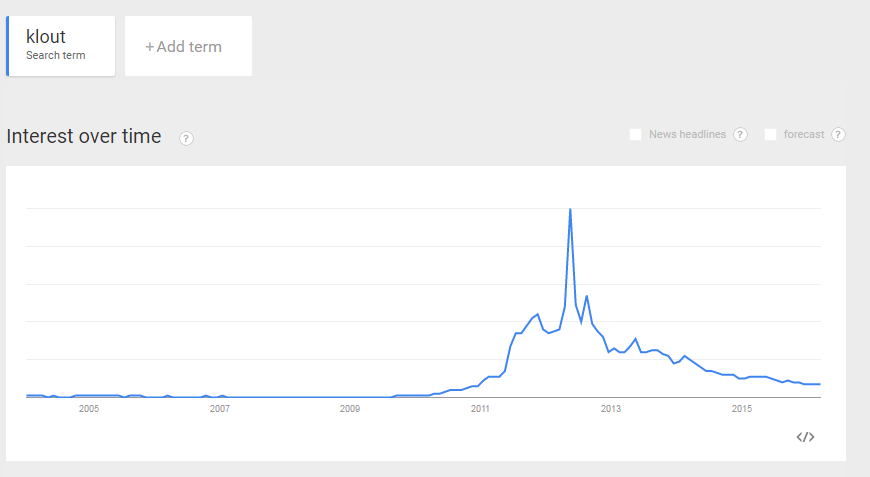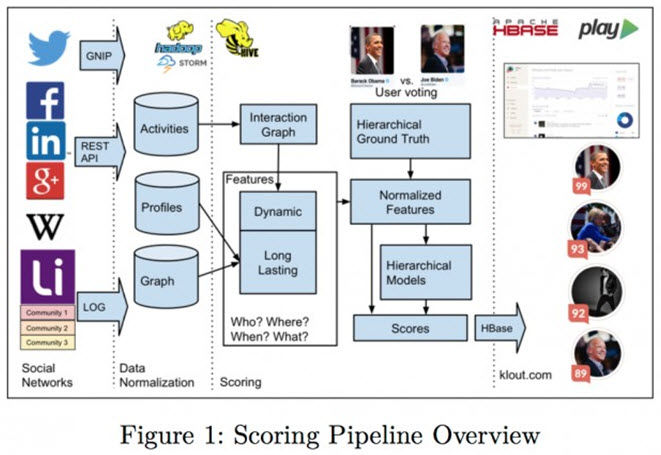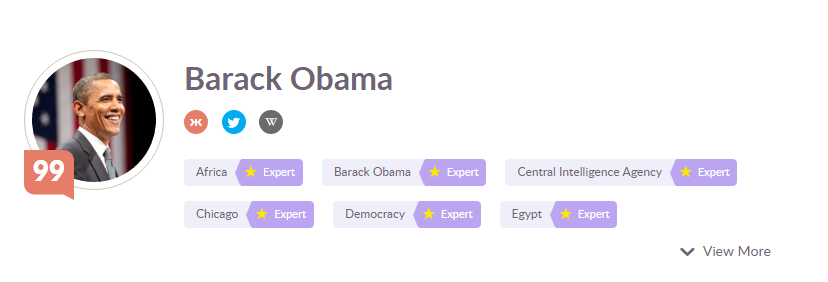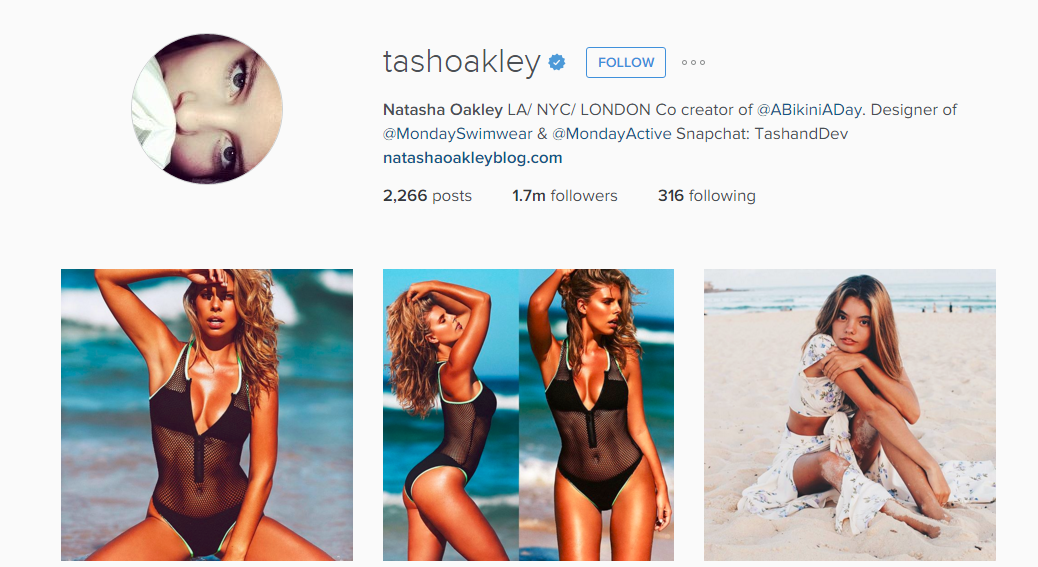
I came across a tweet the other day from a follower giving a +K to another user, which serves as a reward for someone’s expertise, and it reminded me that Klout is still out there, although I haven’t visited it for years.
What is Klout?
It was back in 2008 when Klout was introduced to everyone as an online platform measuring social media influence. Klout aggregates a user’s performance (ranging from followers to engagement) among several social networks in order to calculate the Klout score, counting from 0 to 100, depending on the online influence someone has.
Although it wasn’t the only site that attempted to measure online influence, Klout quickly became popular for its measuring algorithm, which was a mystery for many years.
Image source: Garry McLeod
How we became obsessed with our score
It was in 2012 when Klout reached its peak popularity, as passionate social media users became obsessed with their Klout scores, looking for ways to improve their numbers and then use them accordingly as a way to prove their online credibility.
In fact, it was believed back then that a high Klout score could lead to great rewards, both in the online and offline world, and a new form of rising influence with endless opportunities.
Many companies were fascinated by this measurement platform that allowed them to separate the influencers from the average Internet users and they even turned a high Klout score into a job requirement for their hiring process.
Klout realised its rising power and launched ‘Perks’, a service that rewards influencers with perks coming directly from companies that joined the program.
It was the first time that users could officially monetise their online influence with actual rewards, and they were happy to do so.
However, Klout Perks disappeared at the end (Read more...) 2015, as Lithium Technologies, the company that bought Klout in 2014, decided to focus mostly on the algorithm and its powerful social data.
Why we moved beyond the Klout score
Klout recently released a paper analysing how its score is calculated and all the factors that determine the measurement of a user’s influence.
According to Klout, its scoring system processes 45 billion interactions daily and analyses 3,600 different actions that define the score that is assigned to its 750 million users from nine networks (Facebook, Twitter, LinkedIn, Google+, Youtube, Lithium Communities and Wikipedia).
Image source: Klout
Although the algorithm takes into consideration many factors to determine a user’s influence, it still doesn’t include rising social networks, such as Snapchat and Vine, or it doesn’t consider Pinterest and blogging platforms, despite the fact that a user may connect these to a Klout profile.
Thus, Klout struggles to keep up with all the changes on social media and this inability to include the rising social networks on its measuring algorithm makes its score incorrect, or at least, not as relevant as it hoped to be.
the worst class i took in college was a social media class. we got graded based on our klout scores. i can’t believe someone approved that.
— Maya Kosoff (@mekosoff) March 28, 2016
It’s not that we got past our vanity to measure our social presence, as it may still serve as an indication of someone’s influence, but we now seem to realise that we can’t take it as seriously as we did, if we ever did.
How do we define social influence today?
Klout might not be the primary measurement of influence anymore, but social influencers gained significant power lately, turning their social recognition into a profession.
Many brands seek online ambassadors to promote their products and Instagram appears to be their most popular choice, as it blends the visual appeal and the increasing engagement with the business leads.
Although the number of followers is still important in many cases, it’s certainly not an indication of a user’s influence, as a number may be misleading (and that’s also the case with Klout and how we stopped relying on just a number).
Tyler Oakley started creating videos while he was in college and he counts today more than 8 million subscribers, turning his hobby into a profitable job.
It’s the engagement an influencer creates and the ability to affect users that matters most to brands, and this can be analysed today through numerous platforms, or simply by taking a closer look at a user’s online presence.
What’s more, what Klout failed to depict was the fact that every platform is different, which means that it also leads to a different type of influence. Social influencers nowadays may focus on a specific platform, or they may create a unified social presence, which requires the necessary attention on each social network separately.
For example, Barack Obama, Donald Trump, Kim Kardashian and Justin Bieber, who all have a Klout score higher than 90 out of 100, belong to the social influencers that are all over the web and may use their social power every way they want.
However, the freedom of social media and the call for authenticity created a new type of influencer, the self-made ones that usually focus on a single platform and create an engaged community who is ready to listen to their suggestions and their reviews. Though they cannot be compared (yet) with the influencers mentioned above, as they don’t have the same exposure to media, they still manage to build a solid presence, which makes brands chase a collaboration with them.
Natasha Oakley is considered one of the biggest influencers in the swimwear fashion industry in 2015 and counts 1.7 million followers on Instagram, also promoting her own swimwear brand.
Yes, social influence gets more complicated day by day, but it’s another sign how social media is maturing and so does the users’ influence.
It may not be easy to consider yourself a social influencer, but this makes it more challenging, and usually more rewarding.
Related reading
Will Instagram’s new algorithm mean the death of organic reach for your brand? Not necessarily. Here’s how you use the update to your advantage.
Instagram can be a very effective social network and the fitness industry in particular seems to have found the sweet spot here in ... read more
China is a key market for KLM Royal Dutch Airlines and it is engaging specialized CRM tools on its WeChat account to engage them for customer service.
In B2B social media there are a few accepted ‘truths’. B2B can’t work on Facebook or Pinterest. Instagram is a waste of ... read more



